Do you have a question about the Pioneer VSX-5300 and is the answer not in the manual?
Covers warnings related to electric shock, polarization, and proper power cord usage.
Guidelines for safe placement, ventilation, water exposure, and grounding.
Instructions regarding damage requiring service and user servicing limitations.
Adjusting voltage selectors and channel step/de-emphasis settings.
Setting speaker impedance and understanding memory functions.
Details on Stadium, Simulated Surround, and Dolby Surround modes.
Examples for optimal placement of surround sound speakers.
Explains different sound dispersion effects based on speaker setup.
Features for reducing VCR tape hiss and creating simulated stereo sound.
Diagrams for connecting turntables, CD players, and tape decks.
Instructions for connecting speaker systems and setting impedance.
Diagrams for connecting VHF/UHF antennas, VCRs, and normal TVs.
Details for connecting RF modulators and monitor TVs.
Guide for connecting surround speaker systems to the receiver.
Instructions for connecting an external monaural amplifier.
Connecting the receiver with a separate stereo power amplifier.
Connecting the receiver with a separate stereo preamplifier.
Diagram illustrating a multi-amplifier system with crossover network.
Guidance on positioning cassette decks to prevent hum.
Illustrates audio connections involving cassette decks and graphic equalizers.
Diagrams showing VCR connections to multiple TV monitors.
Identification of antenna and ground connection terminals.
Locating terminals for surround and main speaker outputs.
Overview of various control and audio/video output jacks.
Identification of power switches and impedance selector.
Detailed description of antenna, ground, and surround balance controls.
Explanation of remote control input/output and video output jacks.
Details on speaker terminal connections and impedance selector settings.
Information on switched and unswitched AC outlets and safety precautions.
Details on connecting phono, CD, tape decks, and DATs.
Instructions for connecting pre-amps, power amps, and VDP/CDV players.
Guide for connecting VCRs for playback and recording.
Diagrams and identification of front panel controls and display indicators.
Operation of power, VCR noise filter, and TV/Antenna selector switches.
Using simulated stereo and managing acoustic memory presets.
Selecting tuning modes (Auto/Manual) and inputting station names.
Controls for FM mode, sound level, muting, and speaker balance.
Adjusting master volume, surround modes, speaker selection, and video settings.
Indicators for input selection and TV antenna mode.
Indicators for tuning status, stereo reception, and noise filter.
Indicators for surround modes, video selection, and sleep timer.
Indicators for tone settings, acoustic memory, and other functions.
How to directly tune to specific broadcast frequencies using number keys.
Using automatic scanning or manual step-by-step tuning for broadcasts.
Instructions for storing desired station frequencies into memory presets.
How to recall and listen to previously stored broadcast stations.
Procedure for assigning custom names or call letters to preset stations.
Detailed steps for memorizing station names via the remote control.
Guide to selecting input sources for various audio components.
How to receive FM simulcast TV programs while viewing video.
Instructions for connecting and viewing video sources.
Steps for recording audio sources onto a tape deck.
Instructions for copying tapes between tape decks.
Using the tape monitoring feature during recording.
Procedure for recording audio signals onto a Hi-Fi VCR.
Steps for copying video tapes between VCR1 and VCR2.
How to use the video enhancer function for tape copying.
Guide to using the video signal selector for audio/video switching.
Schematic diagram illustrating the audio and video signal flow.
Tips for better FM reception using external antennas and grounding.
Recommendations for improving AM reception with different antennas.
Instructions for inserting batteries and understanding remote control range.
Precautions and procedures for replacing remote control batteries.
Using the remote control for audio equipment operation.
Using the remote control for video equipment operation.
Explanation of remote control keys for tape deck functions.
Explanation of remote control keys for VCR functions.
Explanation of remote control keys for CD player functions.
Explanation of remote control keys for VDP (LD player) functions.
Using remote keys for surround settings and master volume.
Operating input selection and receiver power using the remote.
Remote functions for muting, sleep timer, and balance adjustment.
Remote control keys for tuner presets and turntable operation.
Remote control keys for operating TV functions like channels and power.
Solutions for problems with power not turning on or controls not responding.
Troubleshooting no sound or no picture issues.
Addressing noise, auto stop malfunctions, and poor signal reception.
Solutions for issues encountered during video tape copying.
Detailed technical data for amplifier output and tuner performance.
Specifications for video section, inputs, outputs, and other features.
Information on power consumption, dimensions, and weight.
Covers warnings related to electric shock, polarization, and proper power cord usage.
Guidelines for safe placement, ventilation, water exposure, and grounding.
Instructions regarding damage requiring service and user servicing limitations.
Adjusting voltage selectors and channel step/de-emphasis settings.
Setting speaker impedance and understanding memory functions.
Details on Stadium, Simulated Surround, and Dolby Surround modes.
Examples for optimal placement of surround sound speakers.
Explains different sound dispersion effects based on speaker setup.
Features for reducing VCR tape hiss and creating simulated stereo sound.
Diagrams for connecting turntables, CD players, and tape decks.
Instructions for connecting speaker systems and setting impedance.
Diagrams for connecting VHF/UHF antennas, VCRs, and normal TVs.
Details for connecting RF modulators and monitor TVs.
Guide for connecting surround speaker systems to the receiver.
Instructions for connecting an external monaural amplifier.
Connecting the receiver with a separate stereo power amplifier.
Connecting the receiver with a separate stereo preamplifier.
Diagram illustrating a multi-amplifier system with crossover network.
Guidance on positioning cassette decks to prevent hum.
Illustrates audio connections involving cassette decks and graphic equalizers.
Diagrams showing VCR connections to multiple TV monitors.
Identification of antenna and ground connection terminals.
Locating terminals for surround and main speaker outputs.
Overview of various control and audio/video output jacks.
Identification of power switches and impedance selector.
Detailed description of antenna, ground, and surround balance controls.
Explanation of remote control input/output and video output jacks.
Details on speaker terminal connections and impedance selector settings.
Information on switched and unswitched AC outlets and safety precautions.
Details on connecting phono, CD, tape decks, and DATs.
Instructions for connecting pre-amps, power amps, and VDP/CDV players.
Guide for connecting VCRs for playback and recording.
Diagrams and identification of front panel controls and display indicators.
Operation of power, VCR noise filter, and TV/Antenna selector switches.
Using simulated stereo and managing acoustic memory presets.
Selecting tuning modes (Auto/Manual) and inputting station names.
Controls for FM mode, sound level, muting, and speaker balance.
Adjusting master volume, surround modes, speaker selection, and video settings.
Indicators for input selection and TV antenna mode.
Indicators for tuning status, stereo reception, and noise filter.
Indicators for surround modes, video selection, and sleep timer.
Indicators for tone settings, acoustic memory, and other functions.
How to directly tune to specific broadcast frequencies using number keys.
Using automatic scanning or manual step-by-step tuning for broadcasts.
Instructions for storing desired station frequencies into memory presets.
How to recall and listen to previously stored broadcast stations.
Procedure for assigning custom names or call letters to preset stations.
Detailed steps for memorizing station names via the remote control.
Guide to selecting input sources for various audio components.
How to receive FM simulcast TV programs while viewing video.
Instructions for connecting and viewing video sources.
Steps for recording audio sources onto a tape deck.
Instructions for copying tapes between tape decks.
Using the tape monitoring feature during recording.
Procedure for recording audio signals onto a Hi-Fi VCR.
Steps for copying video tapes between VCR1 and VCR2.
How to use the video enhancer function for tape copying.
Guide to using the video signal selector for audio/video switching.
Schematic diagram illustrating the audio and video signal flow.
Tips for better FM reception using external antennas and grounding.
Recommendations for improving AM reception with different antennas.
Instructions for inserting batteries and understanding remote control range.
Precautions and procedures for replacing remote control batteries.
Using the remote control for audio equipment operation.
Using the remote control for video equipment operation.
Explanation of remote control keys for tape deck functions.
Explanation of remote control keys for VCR functions.
Explanation of remote control keys for CD player functions.
Explanation of remote control keys for VDP (LD player) functions.
Using remote keys for surround settings and master volume.
Operating input selection and receiver power using the remote.
Remote functions for muting, sleep timer, and balance adjustment.
Remote control keys for tuner presets and turntable operation.
Remote control keys for operating TV functions like channels and power.
Solutions for problems with power not turning on or controls not responding.
Troubleshooting no sound or no picture issues.
Addressing noise, auto stop malfunctions, and poor signal reception.
Solutions for issues encountered during video tape copying.
Detailed technical data for amplifier output and tuner performance.
Specifications for video section, inputs, outputs, and other features.
Information on power consumption, dimensions, and weight.
| Channels | 7.2 |
|---|---|
| Power Output | 80W per channel (8 ohms, 20 Hz-20 kHz, 0.08% THD, 2 channels driven) |
| Total Harmonic Distortion | 0.08% |
| Input Sensitivity | 200 mV |
| Type | AV Receiver |
| HDMI inputs | 4 |
| HDMI outputs | 1 |
| 4K Ultra HD Pass-through | Yes |
| Dolby Atmos | Yes |
| DTS:X | Yes |
| Bluetooth | Yes |
| Speaker Impedance | 6-16 ohms |
| Frequency Response | 10 Hz-100 kHz |
| Signal-to-Noise Ratio | 98dB |
| HDR Support | Yes (HDR10, Dolby Vision, Hybrid Log-Gamma) |
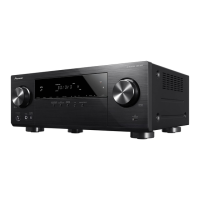

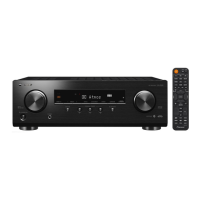
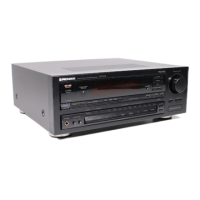
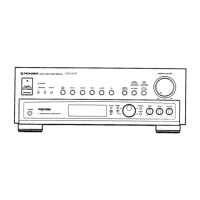
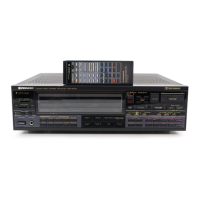


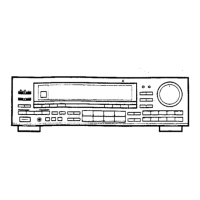

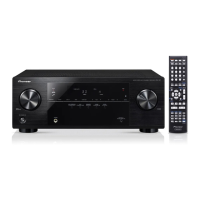
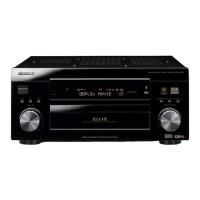
